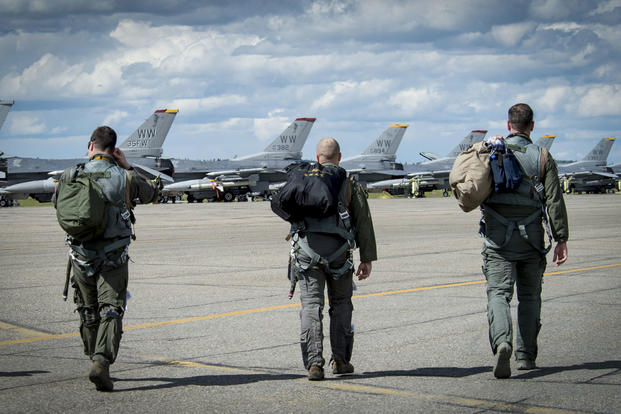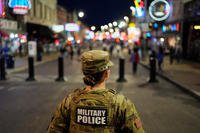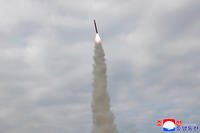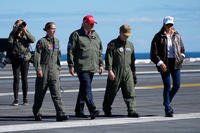The Air Force will give select fighter pilots and aircrew the ability to stay in rotations longer at select commands and bases in an effort to create stability for airmen affected by the growing pilot shortage.
The service on Thursday announced the Second Assignment In-Place Pilot Program, or SAIP, for active duty late-career fighter pilots and weapon system officers is immediately taking effect.
"This is the first iteration as a program -- the 'pilot' pilot program -- where we'll learn and we can make adjustments as we go, but the real focus is to capture that key instructor pilot to grow our inexperienced aviators," said Brig. Gen. Mike Koscheski, the new leader of the Air Force's aircrew crisis task force set up last year by the Pentagon.
Koscheski told Military.com the target audience for this program will be small: lieutenant colonels or lieutenant colonel selects with 17 or more years of Total Active Federal Military Service, or majors not selected for promotion with 14 or more years TAFMS in career fields 11F Fighter Pilot and 12F Fighter Combat Systems Officers will be eligible.
Furthermore, the program will be open to those airmen who have less than a three-year active-duty service commitment and fill instructor pilot or evaluator pilot billets.
Related content:
- Air Force Boosts Pay Incentives, Targets Retirees Amid Pilot Shortage
- Air Force Gets Creative to Tackle Pilot Shortage
- New Bonus: $455K Over 13 Years for Air Force Fighter Pilots
- US Military, Airline Officials to Discuss Pilot Shortage
- How Many Fighter Jets Does the Air Force Need?
The point is to go another three years without having to permanent change of station, or PCS, the general said. It's for those "coming towards the end of their assignment at the base they're at -- we call it 'vulnerable to move,'" Koscheski said.
"They can sign up [for the] program which basically resets the clock," he said.
Eligible Bases, Airmen
The effort comes two weeks after the service announced it will begin increasing its flight incentive pay and aviation bonus programs -- and even asking retirees to come back into the service -- to deal with an ongoing shortage.
Aviation bonuses and incentive pay will not be altered in any way for the individuals who will volunteer for SAIP, Koscheski clarified.
The Air Force said SAIP will be available to 11F and 12F Air Force Specialty Codes at the following sixteen bases at three major commands:
Air Education and Training Command
12th Flying Training Wing, Randolph AIr Force Base, Texas; 14th Flying Training Wing, Columbus AFB, Miss.; 81st Fighter Squadron, Moody AFB, Ga.; 33d Fighter Wing, Eglin AFB, Fla.; 47th Flying Training Wing, Laughlin AFB, Texas; 56th Fighter Wing, Luke AFB, Ariz.; 54th Fighter Group, Holloman AFB, N.M.; 550th Fighter Squadron, Kingsley Field, Ore.; 71st Flying Training Wing, Vance AFB, Okla.; and 80th Flying Training Wing, Sheppard AFB, Texas;
Air Combat Command
53d Wing, Eglin AFB, Fla.; 4th Fighter Wing, Seymour-Johnson AFB, Fla.; 325th Fighter Wing, Tyndall AFB, Fla.; and 355th Fighter Wing, Davis-Monthan AFB, Ariz.
Air Force Materiel Command
96th Test Wing, Eglin AFB, Fla.; and 412th Test Wing, Edwards AFB, Fla.
Koscheski estimates based on criteria, it will be at most 10 airmen per unit.
"Total effect ... it will be south of 100 [people]," he said. Wing commanders "already know which instructor pilots or instructors WSOs (know throughout the Air Force as "wizzos") are candidates for this...and we look to make those matches," Koscheski said.
Keeping the program small at first will guarantee minimal impact on current assignment cycles, he said.
Trial Run
The cycle to start this program has been synced with the next fiscal 2018 assignment list, that way leadership can monitor who signs up for the SAIP.
"Within four months we'll have [our first] assessment," Koscheski said.
The take-rate will determine whether the Air Force should expand the program to target other units across. For those who will not sign up, the service will survey these members to learn what other factors may be limiting them from staying in longer.
"We anticipate this will be a relatively successful program," said Koscheski, an F-15 pilot.
Since Air Force National Guard and Reserve duties are more often than not tied to location, active-duty pilots will be the primary focus of SAIP right now, Koscheski said.
When it expands, it will expand across the 11X and 12X AFSCs such as experimental, helicopter, and mobility pilots and Special Operations combat system, generalist, and bomber combat systems operator officers.
He added, "We're listening to the ... pilots out in the field, mid-career, 12-ish years ... and so, what they're really looking for is stability. Second Assignment In Place kind of goes after those areas for those folks."
Long-Term Solutions
Air Force Secretary Heather Wilson and Chief of Staff Gen. David Goldfein have said the service was 1,555 pilots short by fiscal 2016, which includes 1,211 total force fighter pilots.
But it hasn't come as a total shock.
Pilots are being courted by civilian airlines which offer competitive if not exponentially higher bonuses, service officials have said. Airmen are also unsatisfied with work-and-family dynamic with constant PCS moves, and have also expressed miscellaneous duties bog them down.
Koscheski noted the service last August began removing such "additional duties" typically assigned to airmen at the unit level. It has since cut 29 of 61 additional duties identified under Air Force Instruction 38-206, "Additional Duty Management."
Still, that shortfall is expected to grow once the fiscal 2017 numbers come in, Koscheski said, who didn't want to speculate what the number could be.
"The national pilot shortage is a crisis," retired Gen. Herbert "Hawk" Carlisle told Military.com Wednesday. "For the US military, this crisis could affect our ability to support the National Security Strategy in the future. The U.S. Air Force is doing everything in their power to address this challenge," said Carlisle, the former head of Air Combat Command and current president and chief executive officer of National Defense Industrial Association, an industry trade group.
Responding to SAIP, Carlisle said, "This proposal is a good short-term approach to keep critical pilot skills in the Air Force. Ultimately, though, we have to find the long term solution to this crisis."
The service isn't there -- yet.
"Our production numbers are pretty stable," Koscheski said, in part to ramp up training and get to the Air Force's goal of roughly 1,400 new pilots in the mid-2020s.
Koscheski said it will take all hands -- including from industry -- to get those numbers to climb to that goal. The latest "initiative is part of assignments overall push, but realize we're doing multiple things across aircrew crisis task force" to get pilots in, flying, and staying in, Koscheski said.
-- Oriana Pawlyk can be reached at oriana.pawlyk@military.com. Follow her on Twitter at @oriana0214.































